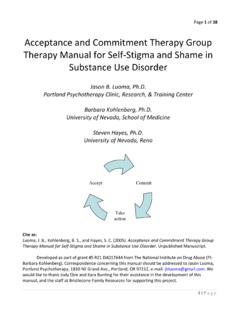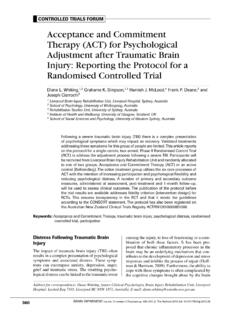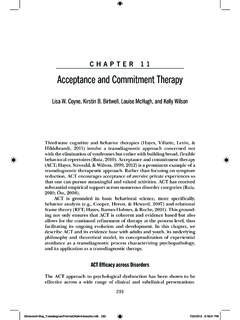Transcription of A Short Guide to Acceptance and Commitment …
1 A Short Guide to Acceptance and Commitment therapy The Process of Acceptance and Commitment therapy Assessment Robust psychological assessment covering a detailed functional analysis of the presenting problem. Consideration of typical patterns of symptoms, thoughts, feelings, and behavioural responses. Particularly looking for avoidant responding and unproductive efforts to control experience that result in not pursuing valued goals. Assessment also covers social circumstances, historical influences on current behaviours. Like many other psychological therapies, diagnostic assessment is considered less important. The primary focus is on workability of strategies the person is using to live their life / solve their problems and the functional analysis of current behaviour, thoughts and feelings.
2 Case Conceptualisation Unlike Cognitive therapy , ACT therapists rarely present an explicit case formulation. Instead the therapist uses metaphors to describe the typical functional characteristics that the client presents with and ask the client if this idea fits with their direct experience. Examples include the sailing boat metaphor, the passengers on the bus metaphor, the man in the hole metaphor, the tug of war with a monster metaphor. Creative Hopelessness In this phase you are working with the client to help them examine the workability of the strategies they are using. In this phase the main objective is to examine what the client has been doing, how well it has worked and examining if perhaps these strategies are part of the problem. Central messages are that attempts to control experiences may be part of the problem rather than the solution.
3 Further important messages are that the client is not broken, just using unworkable strategies to live with what life is giving (or has given) them. The purpose is to recognise that more of the same will be unlikely to be helpful, that this therapy will need to be something new and different to what they have done before and that letting go of unworkable strategies may mean cultivating a willingness to sit with what is difficult or painful, in order that new strategies for living with the problem can be tried. Although this summary sheet presents these three initial stages as separate stages, in reality they can be quite blended, depending on the client and therapist. Doing the ACT work Once the client and therapist have established a good enough working alliance and that there is agreement that what has gone before has not worked well, and that the client is expressing willingness to try and do something new and let go of fruitless strategies, the main work of ACT becomes about defining what the clients wants to be about (their values) and making concrete plans and behavioural steps in those directions.
4 As this happens, the client s mind will start to come up with reasons why this can t happen, wishes to avoid, and fusion with thoughts, beliefs and rules about how life should be lived, about the nature of their problem or about themselves and others. These are basically standing as obstacles between the person and their values We use metaphor, empathy, modelling of Acceptance , experiential exercises, and mindfulness techniques to try and foster willingness to have these obstacles come up, just as they are. The aim is to cultivate an observant, detached and welcoming stance towards these obstacles. We use behavioural interventions such as hierarchies and goal setting, chaining, modelling, role play, and practice to try and model, initiate and reinforce behaviours that move the person towards their valued goals.
5 We use the therapeutic space to help the person discriminate behaviours and circumstances that lead them away from their values and try to give people greater capacity to choose in those moments. For some clients, we need to start with values: what are we going to be doing this strange thing called therapy for? It has to be something that matters to them. Many people are very far away from how they would choose their life to be and this work can be painful and slow. This often involves a great deal of Acceptance and defusion just to get in touch with what matters and allow the possibility that the therapy could be about working for that. Other clients are so fused with thoughts and beliefs about themselves that they need to start with defusion, Acceptance , and really making contact with the unworkability of their strategies and the unhelpfulness of over-thinking and of buying thoughts.
6 Defusion Based Interventions Contrary to cognitive therapy , thoughts are not categorised as rationale or irrational or distorted or functional or dysfunctional. Instead we view the relationship one has with those thoughts as either workable or unworkable in any given moment. We don t even really get into discussing how much a client believes or doesn t believe a thought or belief and we definitely don t get drawn into talking about whether the thought is true or accurate. Instead, we use mindfulness and imagery based exercises, as well as other experiential exercises to help people see thoughts as thoughts, even the really painful ones. We do this in the service of unhooking thoughts as reasons for action, in order that actions become more consistently regulated by the individual s choices towards their values, rather than by what their minds tell them they ought to be doing.
7 We refer to minds as minds, to distinguish mind from self. We point out the construction of language, such as the history of a word, in an effort to see words as words, even when they are about difficult things. We use physicalising gestures and images to characterise thoughts and beliefs as part of the self, but separate from the self. Values Based Interventions Whilst many people may set goals for themselves in some areas of life, many of us simply live with an implicit sense of what is important to us. Other ways of saying this are, What do we want to be about? What matters most to us? For many people, life is so very far from these ideas that they are very alien and quite threatening. For some of us, life is about doing what we are told, what is expected of us, what conforms to our roles. This can be so much so, that in many areas of our lives we are not even aware of choosing, or that choice even exists.
8 Even people who are functioning very successfully in the world may not have considered this aspect of their lives (including the people we call therapists). In this part of the work we attempt to help people make direct experiential contact with those questions: What do I want to stand for? If I got to choose, what would my life be about? What really matters to me? We do this through imagery exercises, sitting in the question and exploring it, and also by the paradoxical strategy of looking at what is painful or avoided. Values and vulnerabilities are poured from the same vessel: in our pain we find what is precious. This is often about connection with other people, feeling we belong and are loved, that we make a difference to the people around us, that we matter, that we care for people in our lives, that we contribute in some way to the world around us.
9 We try to help the person make direct contact with this in their life, and the therapy becomes entirely in the service of living a valued life, with less struggling. Typically this will involve working skilfully with the obstacles that will very naturally arise as the person makes those moves, letting go of strategies that don t work, helping clients to be being willing to have whatever comes up as they move towards values. Part of the work may be about devising concrete behavioural goals in line with these values and breaking these into small steps to allow a series of smaller moves to become bigger moves. All of the thoughts, memories beliefs and everything the client has been struggling with is going to have to come along for the ride. The ACT Therapeutic Stance It might be clear from this summary that the therapeutic stance in ACT is one of equality.
10 The therapist and client are both human beings who have minds. They are both people who have at times known struggle, heartache, joy, sadness, longing and have hurt. They are both people who have acted in ways that they regret or that were not their best selves and they both get caught into rules of how we should be living and what we should do in any given moment. The ACT therapist welcomes this shared humanity and makes attempts to establish equality in the relationship. This might involve selected self disclosure, in the service of the client s values or struggles. A successful ACT therapist is likely to create a mindful, defused, flexible space, in which anything can be discussed in the room, especially process issues as to what is being experienced by both parties, in the here and now. At the same time, the ACT therapist is relatively didactic or guiding, in that they are there for the service of the client s more successful valued living.










